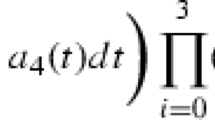Abstract
In most models of population dynamics, diffusion between patches is assumed to be continuous or discrete, but in practice many species diffuse only during a single period. In this paper we propose a single species model with impulsive diffusion between two patches, which provides a more natural description of population dynamics. By using the discrete dynamical system generated by a monotone, concave map for the population, we prove that the map always has a globally stable positive fixed point. This means that a single species system with impulsive diffusion always has a globally stable positive periodic solution. This result is further substantiated by numerical simulation. Under impulsive diffusion the single species survives in the two patches.
Similar content being viewed by others
References
Bainov, D., Simeonov, P. Impulsive di.erential equations: periodic solution and applications. Longman, London, 1993
Beretta, E., Takeuchi, Y. Global asymptotic stability of lotka-volterra di.usion models with continuous time delays. SIAM J. Appl. Math., 48: 627–651 (1988)
Beretta, E., Takeuchi, Y. Global stability of single species di.usion volterra models with continuous time delays. Bull. Math. Biol., 49: 431–448 (1987)
Freedman, H.I., Takeuchi, Y. Global stability and predator dynamics in a model of prey dispersal in a patchy environment. Nonlinear Anal., 13: 993–1002 (1989)
Freedman, H.I. Single species migration in two habitats: persistence and extinction. Math. Model., 8: 778–780 (1987)
Freedman, H.I., Rai, B., Waltman, P. Mathematical models of population interactions with dispersal ii: differential survival in a change of habitat. J. Math. Anal. Appl., 115: 140–154 (1986)
Freedman, H.I., Takeuchi, Y. Predator survival versus extinction as a function of dispersal in a predatorprey model with patchy environment. Appl. Anal., 31: 247–266 (1989)
Freedman, H.I., Waltman, P. Mathematical models of population interaction with dispersal I: stability of two habitats with and without a predator. SIAM J. Appl. Math., 32: 631–648 (1977)
Hastings, A. Dynamics of a single species in a spatially varying environment: the stability role of high dispersal rates. J. Math. Biol., 16: 49–55 (1982)
Holt, R.D. Population dynamics in two patch environments: some anomalous consequences of optional habitat selection. Theor. Pop. Biol., 28: 181–208 (1985)
Funasaki, E., Kot, M. Invasion and chaos in a periodically pulsed mass-action chemostat. Theor. Pop. Biol., 44: 203–224 (1993)
Kuang, Y., Takeuchi, Y. Predator-prey dynamics in models of prey dispersal in two patch environments. Math. Biosci., 120: 77–98 (1994)
Levin, S.A. Dispersion and population interactions. Amer. Natur., 108: 207–228 (1974)
Lakmeche, A., Arino, O. Bifurcation of nontrivial periodic solution of impulsive di.erential equations arising chemotherapeutic treatment. Dynamics of Continuous, Discrete and Impulsive system, 7: 265–287 (2000)
Levin, S.A. Spatial patterning and the structure of ecological communities, in some mathematical questions in biology. VII, Vol. 8, Amer. Math. Soc., Providence, RI, 1976
Liu, X. Impulsive stabilization and applications to population growth models. J. Math., 25(1): 381–395 (1995)
Liu, X., Zhang, S. A cell population model described by impulsive pdes-existence and numerical approximation. Comput. Math. Appl., 36(8): 1–11 (1998)
Liu, X., Rohof, K. Impulsive control of a lotka-volterra system. IMA Journal of Mathematical Control & Information, 15: 269–284 (1998)
Lu, Z.Y., Takeuchi, Y. Permanence and global stability for cooperative lotka-volterra di.usion systems. Nonlinear Anal., 10: 963–975 (1992)
Shulgin, B., Stone, L. et al. Pulse vaccination strategy in the sir epidemic model. Bull. Math. Biol., 60: 1–26 (1998)
Smith, H.L. Cooperative systems of di.erential equations with concave nonlinearities. Nonlinear Anal. TMA., 10: 1037–1052 (1986)
Author information
Authors and Affiliations
Corresponding author
Additional information
Supported by the National Natural Science Foundation of China (No.10171106)
Rights and permissions
About this article
Cite this article
Hui, J., Chen, Ls. A Single Species Model with Impulsive Diffusion. Acta Mathematicae Applicatae Sinica, English Series 21, 43–48 (2005). https://doi.org/10.1007/s10255-005-0213-3
Received:
Revised:
Issue Date:
DOI: https://doi.org/10.1007/s10255-005-0213-3
Keywords
- impulsive diffusion
- stroboscopic map
- boundedness
- monotone concave map
- positive fixed point
- global stability




